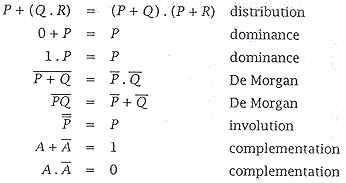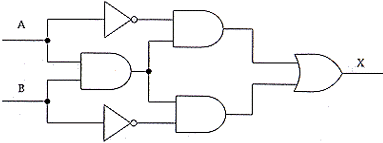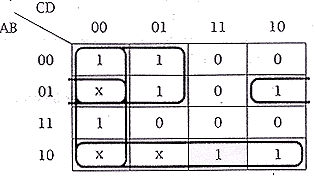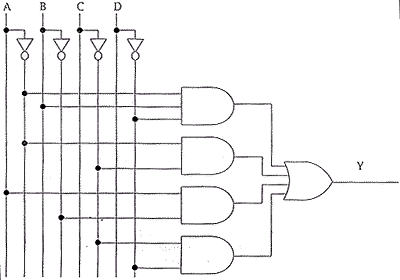| (a) | The following identities are all laws of Boolean
Algebra:
|
[3] | |||||||||||||||||||||||||
| (i) Using the identities given below, show that
A + |
[3] | ||||||||||||||||||||||||||
| A + an equivalent proof using the same set of laws - including De Morgan - should be allowed, as long as every step is properly justified. if the proof is incorrect, two marks; if it is correct as far as it goes, but is incomplete, one mark for each correctly justified step, to a maximun of two; if it is complete and correct, three marks.
|
|||||||||||||||||||||||||||
| (ii) By constructing a truth table, show that A + A.B = A + B is not a law of Boolean Algebra. | [2] | ||||||||||||||||||||||||||
one mark for suitable format of table - as long as there are columns for A + A.B and A + B, then that's fine - plus one mark for completely correct set of entries.
|
|||||||||||||||||||||||||||
| (iii) Complete the following identities to produce the useful laws: | [2] | ||||||||||||||||||||||||||
| (1) |
|||||||||||||||||||||||||||
| (2) A + A. B = A In each case, the expression on the right should be simpler than that on the left. one mark each, total two marks; no other answers should be considered.
|
|||||||||||||||||||||||||||
| (iv) Consider the circuit below:
Show how X can be written as a function of inputs A and B, without simplication. Using laws of Boolean algebra, show how this function for X can be simplified as far as possible. Draw a cicuit to implement the functino with the minimum number of gates. X = one mark for this answer if the proof is incorrect, no marks; if it is correct as far as it goes, but is incomplete, one mark for each correctly justified step, to a maximum of two; if it is complete and correct, and every step is justified, three marks.
one mark for drawing an xor gate
|
[5] | ||||||||||||||||||||||||||
| (b) | The truth table below shows how output Y should
be determined by four inputs A, B, C, and D. An x in the Y column indicates a don't care
condition: the value of Y is not important for the current combination on inputs.
|
||||||||||||||||||||||||||
| (i) Write out a 4-variable Karnaugh map for this table. | [2] | ||||||||||||||||||||||||||
one mark for appropriate style of map (AB against CD), one mark for correct entries.
|
|||||||||||||||||||||||||||
| (ii) By grouping entries in the map, develop a minimal sum-of-products expression for Y in terms of A,B, C and D. | [3] | ||||||||||||||||||||||||||
| one mark for grouping 1's in the
map, one mark for correctly grouping x's as 1's; one mark for the correct sum of products
with respect to the map given (note possibility of consequential error - award mark for
sum of products if it matches the groups made by the candidate. Y =
|
|||||||||||||||||||||||||||
| (iii) Draw a circuit that has Y as an output and A,B,C and D as inputs. | [3] | ||||||||||||||||||||||||||
one mark for appropriate style of circuit, one mark for correct connections, one mark for correct labelling; again, watch for consequential error - circuit should match the sum of products given by the candidate (unless this is completely trivial, in which case it doesn't demonstrate anything) |




